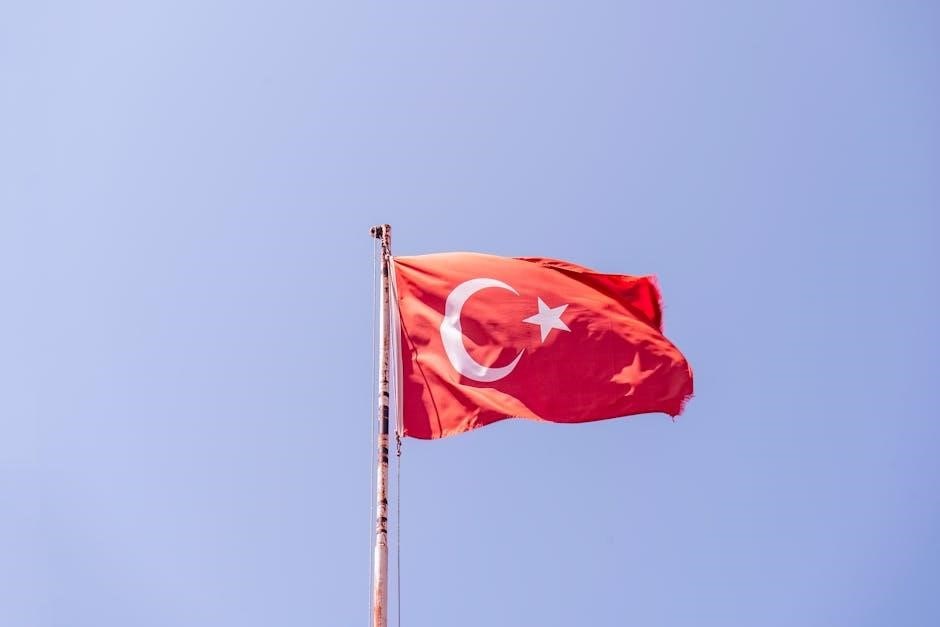The Freedom Curriculum PDF is an educational resource designed to explore the concept of freedom in depth․ It examines historical, philosophical, and societal perspectives, emphasizing the importance of freedom in modern education and its role in fostering critical thinking, individuality, and global understanding․ This curriculum serves as a comprehensive guide to understanding freedom’s significance and its impact on human rights, democracy, and personal growth․

Overview of the Freedom Curriculum
The Freedom Curriculum PDF is a comprehensive educational framework designed to explore the concept of freedom in its various dimensions․ It provides an in-depth analysis of historical, philosophical, and societal perspectives on freedom, emphasizing its importance in modern education․ The curriculum is structured to promote critical thinking, individuality, and global understanding, offering insights into key freedoms such as speech, religion, and assembly․ It also highlights the role of education in fostering a deeper appreciation of freedom and its impact on human rights and democracy․ This resource is ideal for educators and learners seeking to engage with the complexities of freedom in a structured and meaningful way․
Importance of the Freedom Curriculum in Modern Education
The Freedom Curriculum PDF holds significant importance in modern education by fostering a deeper understanding of freedom’s role in shaping societies․ It equips students with critical thinking skills to navigate complex global issues, promoting empathy and inclusivity․ By integrating historical and philosophical perspectives, the curriculum encourages students to appreciate the value of freedom and its impact on human rights․ It also prepares learners to contribute to a more just and equitable world, emphasizing the responsibility that comes with freedom․ This educational tool is essential for developing informed and engaged citizens capable of addressing contemporary challenges effectively․
Key Concepts Covered in the Freedom Curriculum
The Freedom Curriculum PDF delves into essential concepts such as freedom of speech, religion, and assembly, while exploring the distinction between positive and negative liberty․ It examines historical perspectives on freedom, from ancient civilizations to modern times, and highlights the role of education in fostering a deeper understanding of these principles․ The curriculum also addresses the philosophical underpinnings of freedom, emphasizing its significance in shaping societies and individual identities․ By covering these core concepts, the curriculum provides a holistic view of freedom, enabling learners to critically analyze its impact on human rights, democracy, and global progress․ This comprehensive approach ensures a well-rounded understanding of freedom’s multifaceted nature․

Understanding Freedom as a Concept
Freedom is a fundamental concept associated with liberty, autonomy, and the ability to act without undue restraint․ It embodies personal choice, societal rights, and human dignity, shaping individual and collective identities;
Definition and Meaning of Freedom
Freedom is the power or right to act without hindrance or restraint, associated with liberty, autonomy, or free will․ It encompasses the ability to make choices and live without oppression, enabling individuals to express their true selves․ Freedom can be understood in various contexts, including political, social, and personal spheres․ It is a fundamental human right, essential for fostering creativity, innovation, and happiness․ The concept of freedom varies across cultures and ideologies, but its core remains the ability to act and think independently, free from external coercion or control․
Historical Perspectives on Freedom
Historically, freedom has evolved significantly, shaped by societal norms, political systems, and cultural values․ Ancient civilizations, such as Athens, emphasized civic freedom, while others focused on religious or hierarchical structures․ The Enlightenment era brought forth ideas of individual rights and liberty, influencing modern democratic principles․ Franklin D․ Roosevelt’s Four Freedoms—speech, worship, from want, and from fear—highlighted freedom’s multi-dimensional nature․ Throughout history, freedom has been both a goal and a contested concept, reflecting humanity’s ongoing struggle for autonomy and self-determination․ Understanding these historical perspectives is crucial for grasping freedom’s complexities and its role in shaping societies today․
Philosophical Aspects of Freedom
Philosophically, freedom is often debated as a complex and multifaceted concept․ It is associated with autonomy, self-determination, and the ability to make choices free from external coercion․ The distinction between negative and positive liberty—freedom from constraints versus freedom to achieve one’s goals—is central to philosophical discussions․ Thinkers like Kant, Mill, and Rousseau explored freedom’s moral and ethical dimensions, emphasizing its role in human dignity and self-realization․ Philosophical perspectives also examine freedom’s relationship with responsibility, suggesting that true freedom requires a balance between individual rights and societal obligations․ These ideas shape the foundation of ethical and political theories surrounding freedom․
Societal and Cultural Views on Freedom
Societal and cultural perspectives on freedom vary widely, reflecting diverse values and norms․ In some cultures, freedom is seen as individual autonomy, while others emphasize collective well-being․ Many societies view freedom as a fundamental human right, essential for personal growth and dignity․ The Four Freedoms—freedom of speech, religion, from want, and from fear—highlight universal aspirations․ However, cultural interpretations of freedom often influence its application, with some prioritizing community harmony over individual liberties․ The curriculum explores how societal norms shape freedom’s meaning and its role in fostering inclusivity and equity․ Understanding these perspectives is crucial for building a global appreciation of freedom’s significance․

Core Principles of the Freedom Curriculum
The Freedom Curriculum is rooted in essential principles, including free speech, religious freedom, and the right to assemble․ It emphasizes autonomy, equality, and the pursuit of human dignity, fostering a balanced understanding of individual and collective freedoms while promoting ethical responsibility and societal harmony․ These principles form the foundation for educating individuals about the importance of freedom in shaping just and inclusive communities․
Freedom of Speech and Expression
Freedom of speech and expression are cornerstone principles of the Freedom Curriculum, emphasizing the right to communicate thoughts and ideas without censorship or restraint․ This fundamental liberty allows individuals to express their beliefs, opinions, and creativity, fostering a culture of open dialogue and intellectual diversity․ The curriculum explores historical milestones, such as the First Amendment, and contemporary challenges like digital censorship, highlighting the balance between free expression and societal responsibilities․ By teaching the importance of this freedom, the curriculum empowers individuals to engage critically in public discourse and advocate for their rights in a democratic society․ It underscores the transformative power of speech in shaping individual and collective identities․
Freedom of Religion and Belief

Freedom of religion and belief is a cornerstone of human rights, enabling individuals to practice their faith or hold personal convictions without coercion․ This fundamental liberty ensures inclusivity and diversity, allowing people to live according to their values and traditions․ The Freedom Curriculum explores the historical and philosophical roots of religious freedom, emphasizing its role in fostering tolerance and understanding․ It examines how societies balance individual rights with collective responsibilities, addressing challenges like discrimination and extremism․ By promoting education on religious freedom, the curriculum encourages empathy and mutual respect, fostering a harmonious society where diverse beliefs coexist peacefully․ This principle is vital for global unity and human dignity․
Freedom from Fear and Want
Freedom from fear and want ensures individuals can live without constant anxiety or deprivation․ It encompasses security from physical harm and access to essential needs like food, healthcare, and shelter․ This concept, highlighted in the Freedom Curriculum, underscores the importance of societal structures that provide safety nets and protect human rights․ By addressing economic and social inequalities, freedom from want fosters dignity and stability, enabling individuals to thrive․ The curriculum emphasizes the interdependence of personal and collective well-being, advocating for policies that eliminate disparities and promote peace․ This dual freedom is essential for creating a just and prosperous society where all can flourish․
Freedom of Assembly and Association
Freedom of assembly and association is a cornerstone of democratic societies, enabling individuals to gather peacefully and form groups without government interference․ This right fosters collective expression, collaboration, and the pursuit of common goals․ The Freedom Curriculum highlights its importance in promoting social change and holding authorities accountable․ By allowing people to unite, it strengthens civil society and supports the exercise of other freedoms․ However, this liberty is not absolute and may face restrictions to ensure public safety or order; Balancing these interests is crucial to maintaining a vibrant democracy where individuals can freely associate and assemble to address shared concerns and advocate for justice․
Types of Freedom
Freedom encompasses various dimensions, including positive and negative liberty, individual and collective rights, and civil liberties․ These categories explore autonomy, self-determination, and societal structures shaping human experiences․
Positive vs․ Negative Liberty
Positive liberty emphasizes the ability to pursue goals and realize one’s potential, often requiring social enabling․ Negative liberty focuses on freedom from external constraints, such as government interference; Both concepts explore individual autonomy and societal structures․ Positive liberty highlights self-determination and empowerment, while negative liberty stresses the absence of coercion․ These ideas shape discussions on rights, responsibilities, and the role of institutions in ensuring freedom․ Understanding these distinctions is crucial for grasping the complexities of liberty and its application in diverse contexts, from education to governance․ They form the foundation of debates about human rights and the balance between individual and collective freedoms in society․
Individual vs․ Collective Freedom
Individual freedom focuses on personal liberties, such as freedom of speech and religion, emphasizing autonomy and self-determination․ Collective freedom, however, pertains to group rights, like a community’s ability to govern itself or cultural preservation․ The balance between these two is crucial, as individual freedoms often rely on collective structures, such as laws and institutions, to ensure their protection․ Conversely, collective freedom may require individual sacrifices for the greater good․ This tension highlights the complexity of liberty, where personal rights and communal well-being must coexist․ Understanding this dynamic is essential for fostering societies that respect both individual and collective aspirations, ensuring a harmonious balance between the two․
Civil Liberties and Human Rights
Civil liberties and human rights are foundational to the concept of freedom, ensuring individuals are protected from oppression and allowed to thrive․ Civil liberties, such as freedom of speech and religion, are legally protected rights that safeguard personal autonomy․ Human rights, inherent to all individuals, emphasize dignity, equality, and justice․ Together, they form the backbone of democratic societies, ensuring that freedoms are not merely theoretical but practically enforced․ These principles are universal, applying to everyone regardless of race, gender, or nationality․ Protecting civil liberties and human rights requires legal frameworks, ethical awareness, and collective advocacy to prevent abuses and promote a just society where freedom is accessible to all․
Historical Development of Freedom
Freedom’s evolution spans ancient civilizations, the Enlightenment, and modern eras, shaping its definition and application across cultures and societies․ Historical milestones highlight its transformative journey․
Freedom in Ancient Civilizations
In ancient civilizations, freedom was often tied to legal and social status․ Mesopotamia’s Code of Hammurabi and Egypt’s legal codes established rules that, when followed, granted individuals freedom from punishment․ Ancient Greece emphasized freedom as a right of citizenship, with Athens fostering self-governance and intellectual liberty․ Rome later adopted similar principles, linking freedom to civic participation․ However, these freedoms were often limited to specific classes, excluding slaves and non-citizens․ The concept of freedom in ancient times laid the groundwork for modern interpretations, highlighting its evolution as a societal and philosophical ideal across cultures and eras․
Freedom During the Enlightenment
The Enlightenment era (17th–18th centuries) was a pivotal period for the concept of freedom․ Thinkers like John Locke, Jean-Jacques Rousseau, and Voltaire championed ideas of natural rights, liberty, and reason․ Locke argued that individuals had inherent rights to life, liberty, and property, influencing modern democratic ideals․ Rousseau’s social contract theory emphasized collective sovereignty, while Voltaire advocated for freedom of speech and religion․ These ideas fueled political movements, such as the American and French Revolutions, shaping modern notions of freedom․ The Enlightenment shifted freedom from a privilege of the elite to a universal right, laying the foundation for democratic governance and individual autonomy․
Freedom in the Modern Era
In the modern era, freedom remains a cornerstone of global discourse, evolving to address contemporary challenges․ Digital freedom and online rights have emerged as critical issues, with debates surrounding privacy, censorship, and access to information․ Modern societies grapple with balancing individual freedoms against collective security, particularly in the context of technology and surveillance․ Global movements advocate for human rights, emphasizing the universal nature of freedom․ Despite advancements, restrictions persist, often justified by national security or public order․ The modern understanding of freedom requires a delicate balance between individual liberties and societal responsibilities, ensuring that progress does not undermine fundamental human rights․

Freedom in Education
Freedom in education fosters critical thinking, creativity, and personal growth, empowering individuals to explore ideas and develop their potential without undue restriction, preparing them for society․
The Role of Education in Promoting Freedom
Education plays a pivotal role in promoting freedom by equipping individuals with knowledge, critical thinking, and moral reasoning․ It fosters an understanding of human rights, democracy, and personal autonomy, enabling people to make informed decisions․ Through education, societies cultivate informed citizens who can engage in civic participation and advocate for justice․ It also challenges oppressive systems by empowering marginalized communities․ The Freedom Curriculum PDF emphasizes this transformative potential, highlighting how education can liberate minds and inspire collective action toward a more equitable world․ By nurturing freedom of thought and expression, education becomes a cornerstone of societal progress and individual empowerment․
Teaching Freedom in the Classroom
Teaching freedom in the classroom involves fostering an environment where students can explore and understand the concept through interactive activities and discussions․ Educators can use real-life examples to illustrate the importance of freedom of speech, religion, and assembly․ By encouraging critical thinking, teachers help students recognize the value of autonomy and the responsibilities that come with it․ The Freedom Curriculum PDF provides structured lessons to guide these discussions, ensuring students grasp the complexities of freedom and its impact on society․ This approach not only educates but also empowers students to advocate for justice and equality, preparing them to be active participants in a free society․
Curriculum Design for Freedom Education
The Freedom Curriculum PDF is thoughtfully designed to integrate freedom education into various learning environments․ It emphasizes foundational principles like free speech, religion, and assembly, while encouraging critical thinking․ The curriculum incorporates historical perspectives, philosophical insights, and practical applications to foster a deep understanding of freedom․ Interactive activities and real-world examples are included to engage students and promote global awareness․ By focusing on both individual and collective freedoms, the curriculum equips learners with the skills to advocate for justice and equality․ This structured approach ensures that freedom education is comprehensive, accessible, and impactful for students of all ages and backgrounds․

Freedom and Technology
Freedom and technology explore the balance between digital rights and responsibilities․ Tools like website blockers enhance focus, while online freedoms require safeguarding against distractions and security threats․

Digital Freedom and Online Rights
Digital freedom encompasses the ability to access and share information without censorship or surveillance․ It ensures individuals can express themselves online and protects their privacy․ Online rights are fundamental in the digital age, enabling free speech and open communication․ Tools like privacy software and encryption help safeguard these rights․ However, challenges such as data breaches and government restrictions threaten digital freedom․ Education plays a crucial role in promoting awareness and skills to navigate the internet securely․ By understanding digital rights, individuals can advocate for policies that preserve freedom in the digital space, fostering a more open and inclusive online environment․
Freedom from Digital Distractions
Freedom from digital distractions involves managing screen time and minimizing interruptions․ Tools like website blockers help individuals stay focused, enhancing productivity and mental well-being․ Excessive digital stimulation can lead to fatigue, reducing the ability to concentrate․ By setting boundaries, such as limiting app usage or scheduling digital-free periods, individuals can reclaim their time․ This freedom allows for greater mindfulness and engagement in meaningful activities․ It also fosters creativity and critical thinking, unencumbered by constant digital interruptions․ Balancing technology use is essential to maintain productivity and overall life satisfaction in an increasingly connected world․
Using Technology to Enhance Freedom
Technology plays a pivotal role in enhancing freedom by providing tools for self-expression, education, and connectivity․ Digital platforms enable access to information, fostering informed decision-making and empowerment․ Tools like e-learning platforms and communication apps break geographical barriers, promoting global collaboration․ Technology also supports personal freedom by offering resources for skill development and creativity․ Encryption and privacy tools protect individual autonomy, ensuring freedom from surveillance․ However, balancing technology use is crucial to avoid misuse․ By leveraging technology mindfully, individuals can maximize its potential to enhance freedom, enabling them to thrive in an increasingly interconnected world while safeguarding their rights and privacy․

Freedom in Society
Freedom in society is the balance between individual rights and collective well-being, ensuring people can thrive without infringing on others’ liberties․ It fosters equality and justice․
Freedom and Democracy
Freedom and democracy are deeply intertwined, as democratic systems provide the framework for protecting individual liberties․ Democratic societies ensure freedoms like speech, religion, and assembly through constitutional guarantees․ These rights enable citizens to participate in governance, hold leaders accountable, and shape public policy․ Democracy thrives when freedom is upheld, fostering an environment of open dialogue and pluralism․ However, democracy requires active engagement and responsibility from citizens to maintain its integrity․ The balance between individual freedoms and collective well-being is crucial, ensuring that democracy serves as a safeguard for human rights and dignity․ This interdependence highlights the importance of nurturing both freedom and democratic values․
Freedom and Responsibility
Freedom and responsibility are closely linked, as true liberty requires individuals to act thoughtfully and consider the impact of their actions․ While freedom allows people to make choices, responsibility ensures these choices align with ethical standards and societal well-being․ It emphasizes accountability for one’s decisions and respect for others’ rights․ Balancing freedom with responsibility prevents chaos and promotes harmony, fostering a culture of mutual respect and shared values․ This balance is essential for sustaining a just and equitable society, where individuals can thrive without undermining the freedoms of others․ Thus, freedom without responsibility risks leading to anarchy, while responsibility without freedom stifles creativity and progress․
Freedom in Diverse Communities
Freedom in diverse communities highlights the importance of respecting and valuing differences while promoting equality and inclusivity․ It emphasizes the need for individuals to coexist harmoniously, recognizing that freedom is interpreted and experienced differently across cultures and societies․ In diverse communities, freedom often involves balancing collective rights with individual liberties, ensuring that no group is marginalized or excluded․ Open dialogue and mutual respect are essential to navigate differences and foster a sense of belonging․ By embracing diversity, communities can create an environment where everyone feels empowered to express their identity and contribute to the collective well-being, ensuring freedom is accessible and meaningful to all․
Challenges to Freedom
Challenges to freedom include restrictions, security measures, and global inequalities, highlighting the tension between individual rights and collective safety, and the need for balanced solutions to protect liberty․
Restrictions on Freedom
Restrictions on freedom occur when individuals or societies face limitations on their ability to act or express themselves․ These restrictions can stem from legal frameworks, social norms, or security measures․ While freedom is a fundamental human right, it is not absolute; certain boundaries are necessary to protect the well-being of others and maintain societal order․ For example, laws against hate speech or incitement to violence restrict freedom of expression to safeguard public safety․ Similarly, restrictions on assembly during crises, like a pandemic, aim to protect collective health․ Balancing individual rights with societal responsibilities is crucial to ensuring freedom remains a positive force․ Context plays a key role in determining acceptable limits, as cultural and historical perspectives shape perceptions of what restrictions are justifiable․ Ultimately, restrictions on freedom highlight the tension between personal autonomy and the greater good․
Freedom vs․ Security
Freedom and security are often seen as competing values, requiring a delicate balance․ Security measures, such as surveillance or data collection, may infringe on personal freedoms, while unchecked freedom can lead to risks and instability․ This tension is a recurring challenge for governments and individuals, especially in the digital age․ Historical examples, like the Patriot Act post-9/11, show how security concerns can lead to increased surveillance and diminished privacy․ Philosophically, freedom without security can result in chaos, while excessive security risks authoritarianism․ The debate centers on how to protect rights while ensuring safety, highlighting the need for ethical frameworks and transparency to maintain trust and balance․
Global Perspectives on Freedom
Global perspectives on freedom vary significantly, reflecting cultural, historical, and political differences․ In Western societies, freedom is often associated with individual rights and democracy, while in some Eastern cultures, it may emphasize collective harmony and community welfare․ The Four Freedoms, introduced by Franklin D․ Roosevelt, are widely recognized but interpreted differently across nations․ For instance, freedom from want and fear may be prioritized in developing countries, whereas freedom of speech and religion might be more emphasized in Western democracies․ These diverse views highlight the complexity of freedom as a universal concept, shaped by local contexts and values, making it a dynamic and multifaceted idea globally․
The Freedom Curriculum PDF concludes by emphasizing the importance of understanding freedom’s multifaceted nature, fostering critical thinking, and promoting a society that values liberty and responsibility․

Summarizing the Freedom Curriculum
The Freedom Curriculum PDF serves as a comprehensive guide to understanding the concept of freedom, exploring its historical, philosophical, and societal dimensions․ It delves into key principles such as freedom of speech, religion, and assembly, while addressing challenges like restrictions and the balance between security and liberty․ The curriculum emphasizes the role of education in promoting freedom, highlighting its importance in fostering critical thinking and global understanding․ By examining freedom’s evolution and its impact on human rights, the curriculum aims to empower individuals to navigate complex societal issues responsibly․ It underscores the importance of balancing individual rights with collective responsibilities, ensuring freedom’s enduring relevance in a changing world․
Future Directions for Freedom Education
Future directions for freedom education emphasize integrating innovative teaching methods and technology to enhance understanding of freedom’s complexities․ The curriculum encourages global collaboration, fostering cultural exchange and mutual respect; By incorporating real-world examples and case studies, it prepares learners to address contemporary challenges․ Adaptive learning tools and digital platforms can personalize education, ensuring accessibility for diverse audiences․ The curriculum also advocates for community engagement, empowering individuals to advocate for freedom responsibly․ By aligning education with societal needs, the Freedom Curriculum PDF aims to cultivate informed, empathetic, and active global citizens, ensuring freedom remains a cornerstone of future societies․ This approach ensures its timeless relevance and impact․
The Impact of the Freedom Curriculum on Society
The Freedom Curriculum PDF fosters a deeper understanding of freedom, empowering individuals to advocate for their rights and contribute to a more just society․ By promoting critical thinking and cultural awareness, it encourages individuals to value freedom as a fundamental human right․ The curriculum inspires collective action, fostering a culture of freedom that transcends borders and generations․ Its emphasis on digital freedom, societal responsibility, and global perspectives equips learners to navigate modern challenges effectively․ Ultimately, the Freedom Curriculum PDF plays a pivotal role in shaping a society that prioritizes liberty, equality, and the well-being of all, driving positive change and progress worldwide․
